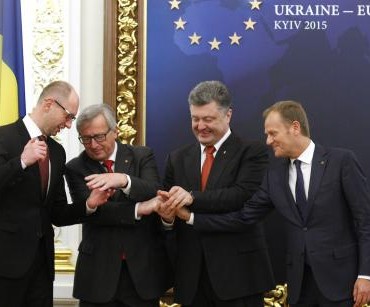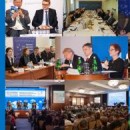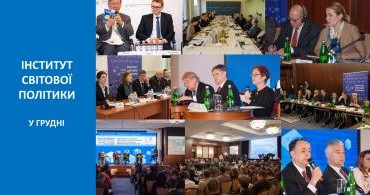An article written by Kristi Raik, Senior Research Fellow at Finnish Institute of International Affairs, based on the results of European thought leaders’ visit to Ukraine which was organized by the Institute of World Policy in partnership with CIDOB.The shorter version of this article was published on “Evropeiska Pravda” (in Ukrainian).
The views expressed in this article are the author’s own and do not necessarily reflect the views of the Institute of World Policy
The Ukrainians made two revolutions within a decade, both giving a boost to the country’s ‘European choice’. Between the Orange Revolution of late 2004 and Euromaidan of late 2013–early 2014, the EU-Ukraine relationship grew increasingly sour. Nevertheless, it gained much new, concrete substance in fields such as trade, energy and visas. The post-Euromaidan leadership can use the Association Agreement, the Energy Community and visa liberalization as instruments to take Ukraine closer to the EU. And yet, the ‘real thing’ – EU membership – appears to be even further away today than it was ten years ago.
During the past year, a breeze of realism has re-shaped EU talk about the neighborhood in general and Ukraine in particular. The EU has been forced to acknowledge its failure to create an arch of stability in the neighborhood. Russia’s aggression against Ukraine has underscored the need to complement the EU’s technocratic focus on domestic reforms with a serious consideration of the geopolitical environment. Brussels is now talking about defending Europe’s interests rather than envisioning a unique foreign policy based on values. The issue of further enlargement is off the agenda.
Altogether, the limits of what the EU can achieve in its Eastern neighborhood are now strongly exposed, although not new. Three handicaps are worth highlighting.
First, the EU is currently not able to agree on a strategy for the Eastern neighborhood. It is hard enough – and hugely important – to maintain the EU’s commitment to the DCFTAs (Deep and Comprehensive Free Trade Agreements), which means integrating the willing neighbors into the common market. The ratification process of the EU-Ukraine Association Agreement (including DCFTA) is moving on and the EU has confirmed its intention to implement the DCFTA part of the agreement from 1 January 2016 onwards. Moscow has objected the agreement, but in a recent rhetoric shift declared that it would no longer try to block it. Trilateral consultations between the EU, Russia and Ukraine on the implementation of DCFTA continue. In a favorable reading, the consultations are a necessary diplomatic gesture towards Moscow that shows readiness to discuss the latter’s concerns, but does not derail the EU-Ukraine relationship.
Economic integration (which, after all, lies at the foundation of the EU) could be an important part of a strategy for those neighbors that are interested in closer ties – for the time being Ukraine, Georgia and Moldova. At the same time, there are other big strategic questions where a common position shared by the 28 member states is not in sight. One is the perennial issue of offering a membership perspective to Ukraine and other interested Eastern neighbors. Back in 2005, the Orange Revolution was followed by a tense debate on this question in the EU. The outcome was nothing more than repeated acknowledgements of the European aspirations of Ukraine and references to ‘new prospects’ and possible ‘further progress’ of the relationship. In March 2014, the EU stated that the Association Agreement did ‘not constitute the final goal’ in EU-Ukraine relations. This was considered an achievement, and yet, it was just a new formulation of essentially the same old message. Today, in May 2015, some member states are not even ready to repeat that formulation in the declaration of the Riga Eastern Partnership summit. The endless exercises of verbal acrobatics are frustrating for everyone involved and take away time from more concrete substance of the relationship.
Another, more dangerous strategic lacuna is the EU’s relationship with Russia, where the common neighborhood has become the most acute issue. Russia keeps signaling its deep dissatisfaction with the post-Cold War European security order and seeks recognition of its sphere of interest in the post-Soviet space. This constitutes a deep and principled disagreement between Russia and the EU. For the latter it is out of the question to define spheres of influence against the will of the countries concerned. However, the EU has struggled to come up with a response to the Russian tactics of using military force and hybrid forms of pressure to advance its goals in the region.
Hence the second handicap: the EU is not able to defend sovereignty and territorial integrity of its Eastern neighbors. In principle, of course, it does not accept the violations committed by Russia. In practice, Russia maintains separatist conflicts in each Eastern Partnership country that is seeking closer ties to the EU. The raw bottom-line of these conflicts is that Russia is ready to use military force in the region, whereas neither the EU nor the US are willing to do so. The EU’s economic sanctions against Russia are a harsher measure than many had expected, but as sanctions in general, they do not yield quick results. The EU’s strategic patience, which Germany has called for, will face a test in June when a decision on the prolongation of sanctions is due.
Thirdly, the EU is not able to turn neighboring countries into stable democracies with viable institutions. Academic studies on democratization suggest that the success of political transition is primarily determined by domestic conditions. External factors can help or hinder, but are generally not decisive. The promise of EU membership is often said to have worked miracles in the past. However, the Baltic countries, for instance, undertook the most radical reforms during the first half of the 1990s, when their membership in the EU and NATO was seen by many in Western Europe as unrealistic and undesirable. The Balts rushed to use the window of opportunity at the time when the big neighbor in the East was weak. Their inclusion in the EU enlargement was confirmed only in 1998 as a result of hard work on two fronts, domestic reforms and diplomacy.
For Ukraine today, the international environment is obviously less favorable, with a resurgent Russia in the East and wavering EU in the West. What is more, Ukraine has yet to convince its partners in Europe about its commitment to a systemic overhaul. ‘You keep reforming, and we will keep supporting’, as stated by President of the European Commission Claude Juncker in Kyiv in April 2015, is the order of the steps ahead. Considering the mood in the EU and the state of play in Ukraine, President Poroshenko was wise to postpone the issue of applying for EU membership to the year 2020. If Ukraine or its supporters among the member states push too hard at this point, they may get a negative response that will be hard to change later on.
The initiative has been implemented due to the support:
“Ukraine National Initiatives to Enhance Reforms” (UNITER) project, funded by the U.S. Agency for International Development (USAID) and implemented by the Pact in Ukraine;
Friedrich Ebert Foundation in Ukraine;
“Initiative on the think tanks development in Ukraine”, operated by International Renaissance Foundation in partnership with the Think Tank Fund (TTF) and funded by the Embassy of Sweden in Ukraine (SIDA).




Comments theme
Comments themeComments themeComments themeComments themeComments themeComments themeComments themeComments themeComments themeComments themeComments themeComments themeComments themeComments themeComments themeComments themeComments themeComments themeComments themeComments.